How the Clenched Fist Became a Black Power Symbol (original) (raw)
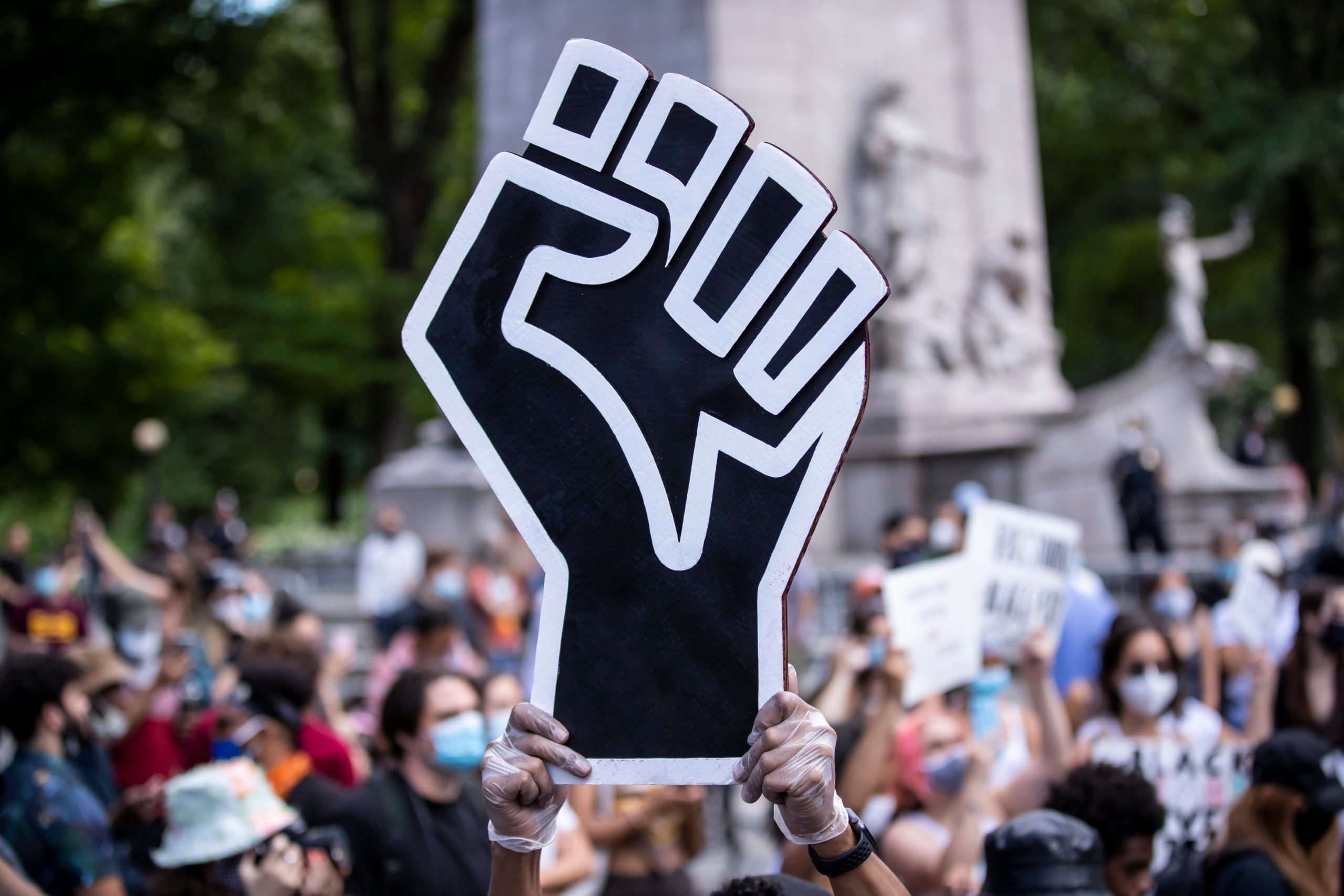 Ira L. Black - Corbis/Getty Images
Ira L. Black - Corbis/Getty Images
A protester holds up a large black power raised fist in the middle of the crowd that gathered at Columbus Circle in New York City for a Black Lives Matter Protest spurred by the death of George Floyd.
What does the black fist mean?
To some, a clenched fist is just a fist. At its worst, it’s something capable of inflicting bodily harm. But beyond a clenched fist’s ability to pummel lies its capacity to unite in support of noble causes. In 2020, the clenched fist (also referred to as the black fist) was tied to the Black Lives Matter (BLM) movement as an emblem of power, pride, and perseverance. The black fist is perhaps most closely identified in the United States with the Black struggle for civil rights (it was also referred to as the Black Power fist), but the clenched fist’s symbolic history goes back to the 19th century when the gesture was used to represent the courage of revolutionaries against the European monarchies. Sometimes, the clenched fist was even tied to some not-so-noble causes. So, where does it stand in the history books? Here, we retrace the clenched fist’s history, the circuitous route it has traveled from the battlegrounds of Europe to the streets of America, and how it’s tied to BLM.
The clenched fist debuts as a symbol of revolutionary spirit
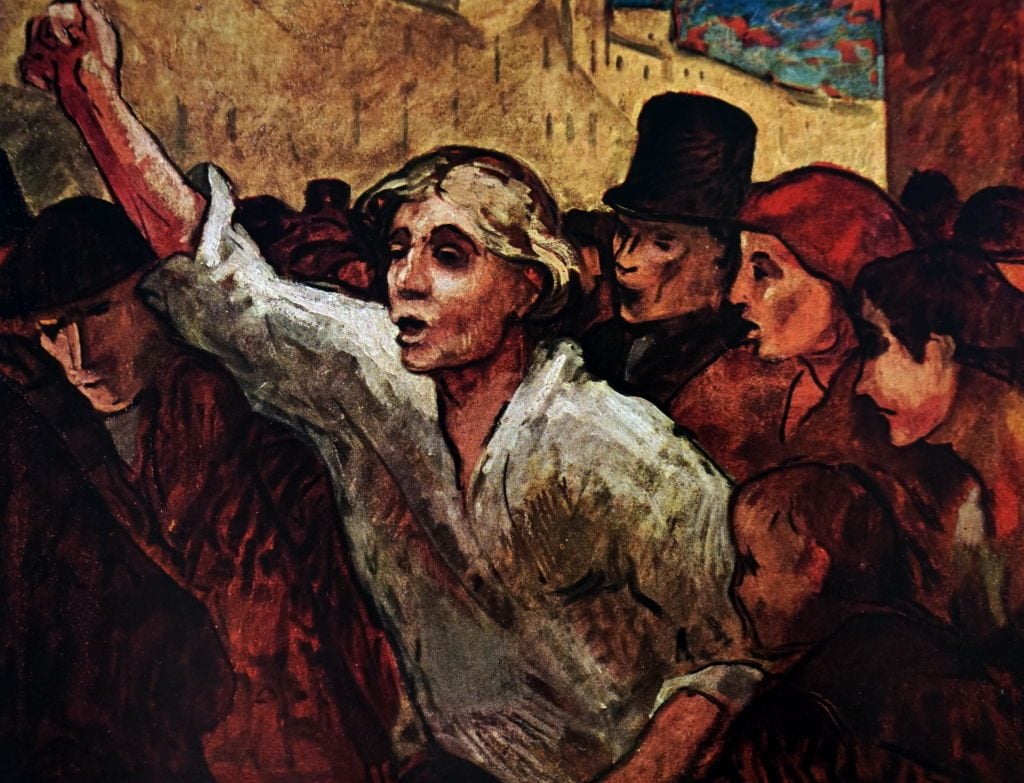 Universal History Archive/Getty Images
Universal History Archive/Getty Images
Honoré Daumier’s The Uprising, 1848
People probably have been clenching their fists for various reasons since the beginning of time. The first likely appearance of a clenched fist as a symbolic gesture, however, was in France during the 1848 revolution that resulted in the abdication of King Louis-Philippe, the last reigning French monarch. It was one of a number of insurrections throughout Europe in 1848. French artist Honoré Daumier is said to have been so affected by the passion of the revolutionaries that he painted The Uprising to represent their fighting spirit. At the center of the piece was a man with rolled-up sleeves and a clenched fist. In his 2000 book French Paintings of the Nineteenth Century, Part I: Before Impressionism, Lorenz Eitner called it “a daring attempt to give monumental form to a modern political subject of dramatic urgency.” Artists are inspired in fascinating ways. Here are some incredible Black artists who have been flying under the radar.
Europe’s anti-fascist movement adopts the clenched fist
Nearly 100 years later, the clenched fist would resurface in another time of war. During the Spanish Civil War of 1936 to 1939, the Republican government used it to symbolize its opposition to the fascist Nationalist rebels led by future dictator Francisco Franco, who ruled Spain from 1939 to 1975. The clenched fist stood in stark contrast to the open-palmed Roman salute used by the Nationalist forces. Although the Republicans lost the war, with the government retreating to France in exile, the clenched fist became a symbol of opposition to fascism as World War II commenced in Europe. BBC writer Jon Kelly noted in 2012: “To this day the clenched fist holding a rose remains the logo of the Socialist International, to which the UK Labour party is affiliated, as well as a number of European socialist parties including those in France and Spain.” Monuments to Franco and other controversial leaders have come under greater scrutiny.
The clenched fist makes it to the Olympics
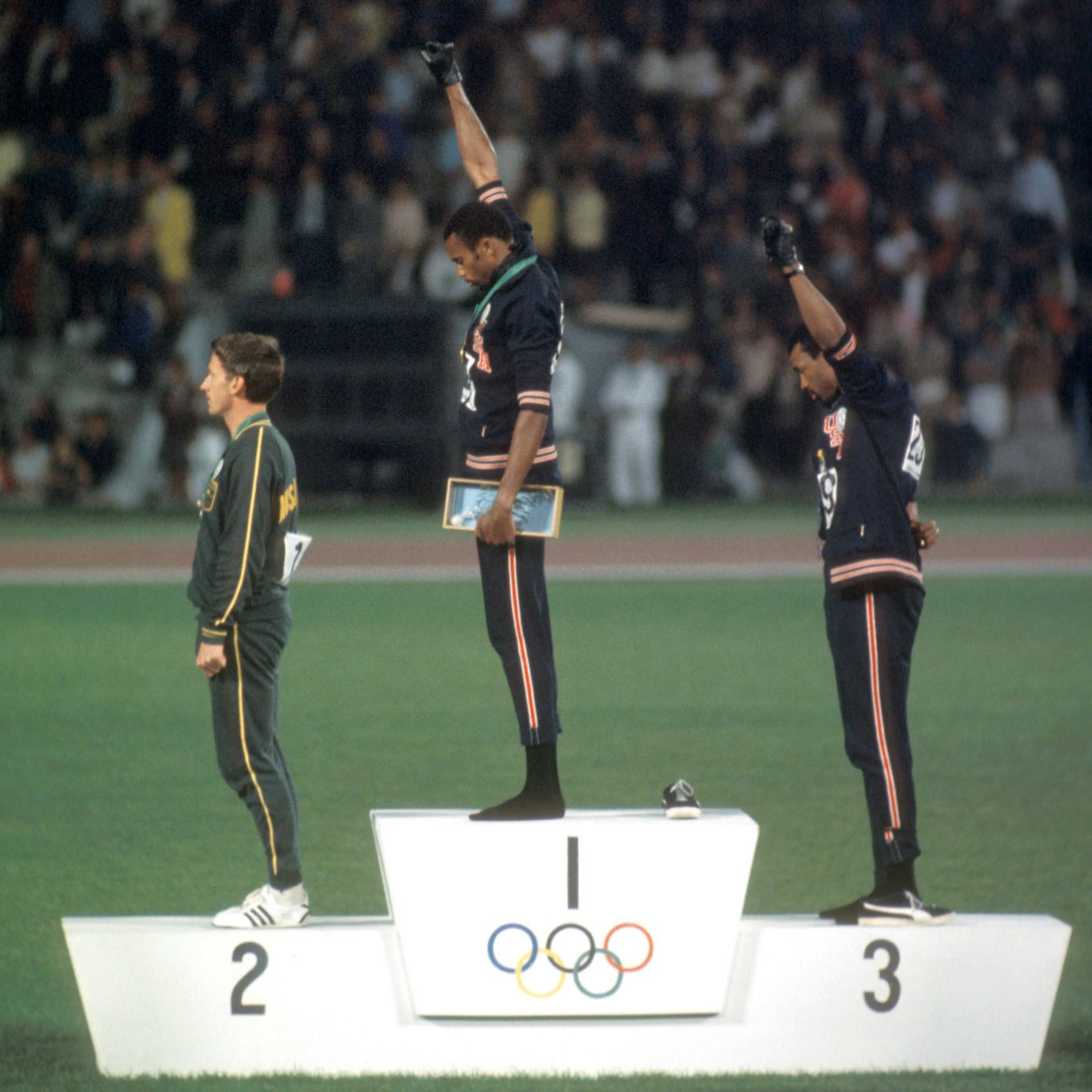 NCAA Photos/Getty Images
NCAA Photos/Getty Images
Tommy Smith (1st place) and John Carlos (3rd place) of the USA raise their fists in the “Black Power Salute” during the playing of the national anthem at the Olympics in Mexico City, Mexico in 1968.
America jumped onto the clenched-fist bandwagon several decades later, and its symbolism became a centerpiece of the 1968 Summer Olympics in Mexico City. At the time, the civil rights movement of the early ’60s had given birth to the Black Power movement of the late ’60s, and Black Americans were still mourning the 1968 assassination of Martin Luther King Jr. Although the Civil Rights Act of 1964 had improved the situation of Black people in the United States, racism and segregation persisted. When two Black American track athletes, Tommie Smith and John Carlos, won gold and bronze medals, respectively, for the 200-meter sprint, each raised a black-gloved fist while standing on the winners’ platform as a form of protest against ongoing racism and injustice in the United States and throughout the world. “[It] was a cry for freedom and for human rights,” Smith told Smithsonian magazine in 2008. “We had to be seen because we couldn’t be heard.” This symbolic protest was just one of many Olympic moments that changed history.
How the clenched fist came to define Black power
Smith and Carlos’s use of the raised fist was a symbolic precursor to NFL player Colin Kaepernick’s bent-knee protest in 2017, and the reaction was similarly mixed. Although regarded as heroic by the Black community, Smith and Carlos were kicked off the U.S. track team and went home to face backlash and death threats. The outrage was connected to the controversial Black Panther nationalist group, which had earlier adopted the clenched fist (also referred to as the Black Power fist) as its logo, representing Black power.
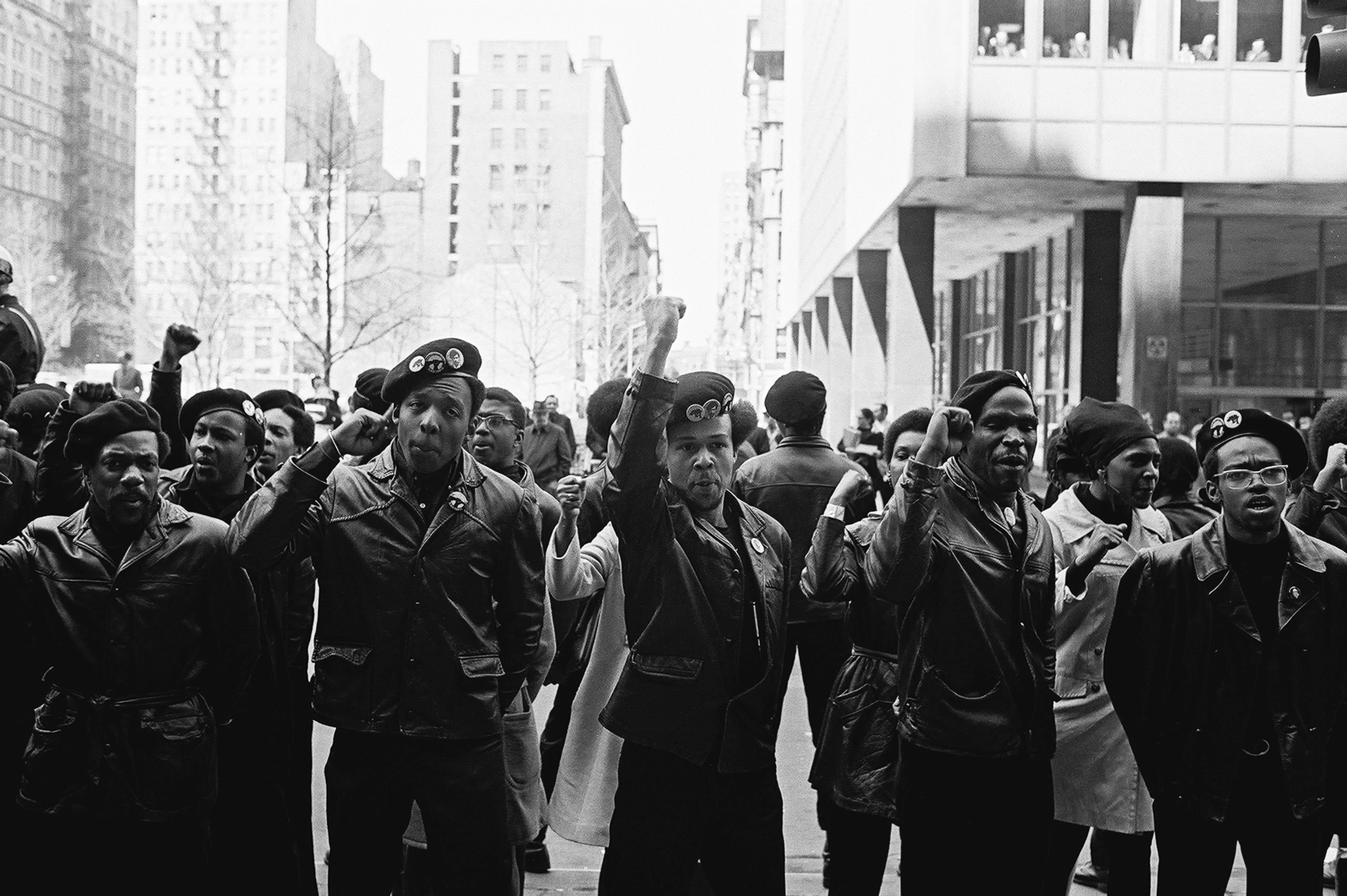 David Fenton/Getty Images
David Fenton/Getty Images
Black Panther Party members demonstrate with fists raised outside the New York City courthouse.
“The gesture has a long history as a symbol of defiance and is often associated with both left-wing politics as well as oppressed groups,” Margaret Chadbourn wrote for ABC News in 2016. “In the 1960s, the Black power movement used it as a gesture to represent the struggle for civil rights.” Although the clenched fist would later be used by other oppressed groups, including feminists and the LGBTQ community, as well as by U.S. Senator Bernie Sanders during his 2016 bid for the Democratic nomination and even former President Donald Trump during his 2017 inauguration, it forever will be inextricably linked to Black pride and Black power. Here’s where the concept of race came from, and why it’s important to know.
The clenched fist is turned into a symbol of evil
Although the clenched fist has come to represent a show of power and perseverance—upon Nelson Mandela’s release from prison in 1990, both he and his wife Winnie raised their fists in triumph—it hasn’t always been used as a symbol for noble causes. Lee Harvey Oswald clenched and raised his fist to salute photographers after he was arrested for assassinating President John F. Kennedy in 1963, and in 2011, far-right terrorist Anders Behring Breivik raised his clenched fist at the start of the second day of his trial for killing 77 people in gun and bomb attacks in Norway. “In the world’s media, the motion was interpreted as a demonstration that the man who killed scores of people in gun and bomb attacks in July 2011 felt no remorse or repentance,” the BBC’s Jon Kelly wrote in 2012. “If Breivik’s performance was widely seen as a further insult to the memories of his victims and their families, it is because he adopted the iconography of political struggle.”
White supremacists abuse the clenched fist
Breivik’s clenched-fist salute was no mere coincidence. During the ’80s, White supremacists adopted the Black power movement’s clenched fist as their own to symbolize White power. According to the Anti-Defamation League, “the White fist…is the symbol of intolerance.” In June 2020, President Trump retweeted a video of apparent Trump supporters on golf carts shouting, “White power!” while raising their fists at anti-Trump protesters. The president faced criticism for appearing to condone the gesture, with Michael D. Shear writing in the New York Times that Trump was “once again using the vast reach of his social media platforms to inflame racial divisions in a nation roiled by weeks of protests about police brutality against Black people and demands for social justice reforms.” While “White power” is a flagrant expression of racism, our language is littered with commonly used words and phrases that have racist implications.
Black Lives Matter reclaims the clenched fist
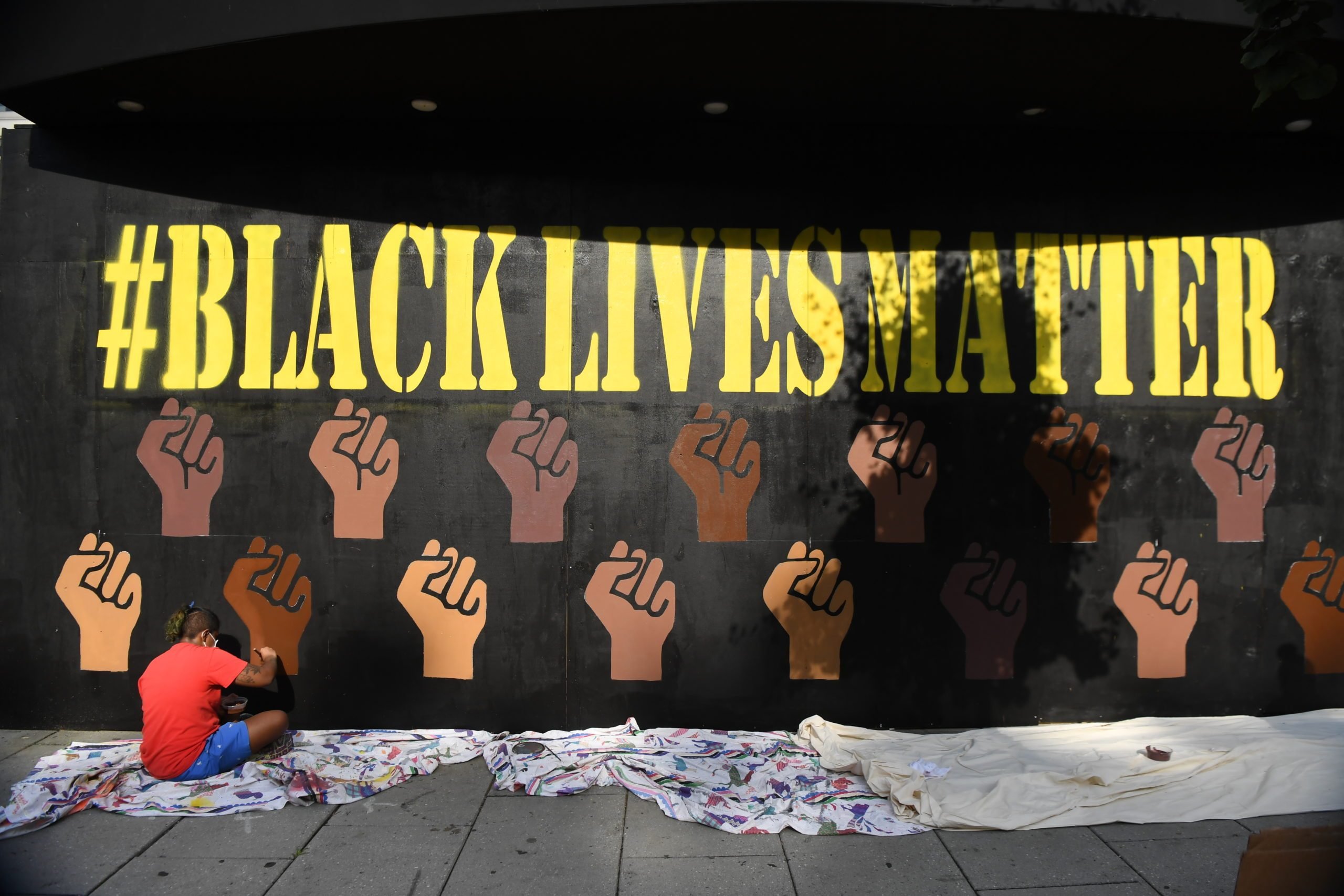 The Washington Post/Getty Images
The Washington Post/Getty Images
Sign painters create a mural on the boarded windows of a nightclub in Washington, DC as protests continue after the death of George Floyd.
Although it never stopped being a symbol of Black pride, the clenched fist (also known as the BLM fist) has made a major comeback with Black Lives Matter supporters of all races, following the murder of George Floyd in Minneapolis in May 2020 by a White policeman who pressed his knee into Floyd’s neck for more than nine minutes. Tributes to George Floyd can be seen across the globe—here are 26 powerful murals dedicated to him.
Black Lives Matter was founded in 2013 following the acquittal of George Zimmerman for the murder of Trayvon Martin, an unarmed black teenager, and the raised fist has become a symbol for the movement. You can even buy it in the form of a “Black Lives Matter Lapel Pin” on Amazon for $9.95. Here’s a list of which BLM charities and organizations to support.
There’s a shirt that depicts three clenched fists raised in solidarity on sale at the Black Lives Matter store, and the enduring symbol is echoed in the organization’s mission statement: “Black Lives Matter Foundation, Inc. is a global organization in the United States, United Kingdom, and Canada, whose mission is to eradicate white supremacy and build local power to intervene in violence inflicted on Black communities by the state and vigilantes. By combating and countering acts of violence, creating space for Black imagination and innovation, and centering Black joy, we are winning immediate improvements in our lives.” Whether you call it the clenched fist, Black Power fist, BLM fist, or solidarity fist, one thing is clear: it’s used as a symbol of Black pride, solidarity, and dedication to fighting injustice. Next, learn what anti-racism means.
For more on this important issue, see our guide to the Fight Against Racism.
Sources:
- The Professional Association for Design: “Not Your Grandparent’s Clenched Fist”
- Britannica: “Louis-Philippe”
- The Phillips Collection
- National Gallery of Art: Honoré Daumier
- Britannica: “Spanish Civil War”
- BBC News: “Breivik: What’s behind clenched-fist salutes?”
- The Guardian: “What’s in a clenched fist?”
- dw.com: “Italy’s parliament votes to outlaw fascist symbols, Roman salute”
- history.com: “How the Black Power Protest at the 1968 Olympics Killed Careers”
- The New York Times: “Tommie Smith’s Fist Is Still Raised: ‘We Still Need to Fight’”
- Smithsonian Magazine: “Olympic Athletes Who Took a Stand”
- ABC News: “A Look at the History of the Clenched Fist”
- The New York Times: “What We Saw as Trump Took Office”
- NPR: “The Day Nelson Mandela Walked Out Of Prison”
- The Guardian: “Anders Behring Breivik gives evidence – Tuesday 17 April”
- Anti-Defamation League: “Hate on Display™ Hate Symbols Database”
- The New York Times: “Trump Retweets Racist Video Showing Supporter Yelling ‘White Power’”
- The New York Times: “How George Floyd Was Killed in Police Custody”